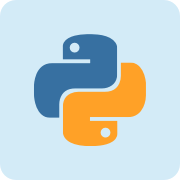Python参考手册
可选操作系统 | Optional Operating System
readline
readline模块定义了许多函数以方便Python解释器完成和读取/写入历史文件。该模块可以直接使用,也可以通过rlcompleter支持在交互式提示符下完成Python标识符的模块使用。使用此模块进行的设置会影响解释程序的交互式提示raw_input()和input()内置函数提供的提示的行为。
注意
底层Readline库API可以由libedit库而不是GNU readline 来实现。在MacOS X上,readline模块会在运行时检测正在使用哪个库。
配置文件libedit与GNU readline 的配置文件不同。如果以编程方式加载配置字符串,则可以检查文本“libedit” readline.__doc__以区分GNU readline和libedit。
Readline键绑定可以通过初始化文件进行配置,通常.inputrc在您的主目录中。请参阅GNU Readline手册中的Readline Init File,了解该文件的格式和允许的结构以及一般Readline库的功能。
1.初始化文件
以下函数与init文件和用户配置有关:
readline.parse_and_bind(string)
执行字符串参数中提供的init行。这调用rl_parse_and_bind()了底层库。
readline.read_init_file([filename])
执行一个readline初始化文件。默认文件名是最后使用的文件名。这调用rl_read_init_file()了底层库。
2.行缓冲区
以下功能在线路缓冲区上运行:
readline.get_line_buffer()
返回行缓冲区的当前内容(rl_line_buffer在底层库中)。
readline.insert_text(string)
将文本插入光标位置的行缓冲区中。这会调用rl_insert_text()底层库,但会忽略返回值。
readline.redisplay()
更改屏幕上显示的内容以反映行缓冲区的当前内容。这调用rl_redisplay()了底层库。
3.历史文件
以下功能在历史文件上运行:
readline.read_history_file([filename])
加载一个readline历史文件,并将其附加到历史列表中。默认文件名是~/.history。这调用read_history()了底层库。
readline.write_history_file([filename])
将历史列表保存到readline历史文件,覆盖任何现有文件。默认文件名是~/.history。这调用write_history()了底层库。
readline.get_history_length()readline.set_history_length(length)
设置或返回所需的行数以保存在历史文件中。该write_history_file()函数使用此值通过调用history_truncate_file()底层库来截断历史文件。负值意味着无限的历史文件大小。
4.历史清单
以下功能在全局历史列表上运行:
readline.clear_history()
清除当前的历史记录。这调用clear_history()了底层库。如果Python是为支持它的库的一个版本编译的,Python函数才存在。
2.4版本中的新功能。
readline.get_current_history_length()
返回历史中当前项目的数量。(这get_history_length()与之不同,它返回将写入历史文件的最大行数。)
2.3版本的新功能。
readline.get_history_item(index)
在索引处返回历史项目的当前内容。项目索引是基于一个的。这调用history_get()了底层库。
2.3版本的新功能。
readline.remove_history_item(pos)
从历史记录中删除由其位置指定的历史记录项目。该职位是从零开始的。这调用remove_history()了底层库。
2.4版本中的新功能。
readline.replace_history_item(pos, line)
通过替换与位置指定的历史项目线。该职位是从零开始的。这调用replace_history_entry()了底层库。
2.4版本中的新功能。
readline.add_history(line)
将行追加到历史记录缓冲区,就好像它是最后一行输入一样。这调用add_history()了底层库。
5.启动挂钩
2.3版本的新功能。
readline.set_startup_hook([function])
设置或移除由rl_startup_hook基础库的回调调用的函数。如果指定了函数,它将被用作新的钩子函数;如果省略或者None已经安装的任何功能被删除。在readline打印第一个提示之前,钩子被调用时没有参数。
readline.set_pre_input_hook([function])
设置或移除由rl_pre_input_hook基础库的回调调用的函数。如果指定了函数,它将被用作新的钩子函数; 如果省略或者None已经安装的任何功能被删除。在第一个提示已被打印之后,在readline开始读取输入字符之前,钩子被调用时没有参数。这个函数只有在Python为支持它的库版本编译时才存在。
6.完成
以下功能与实现自定义字完成功能有关。这通常由Tab键操作,并且可以建议并自动完成输入的单词。默认情况下,Readline被设置为用于rlcompleter为交互式解释器完成Python标识符。如果该readline模块要与自定义完成器一起使用,则应设置一组不同的单词分隔符。
readline.set_completer([function])
设置或删除完成者功能。如果指定了函数,它将用作新的完成函数; 如果省略,或者None已经安装的完成程序功能被删除。完成者函数被调用为function(text, state),对国家的0,1,2,...,直到它返回一个非字符串值。它应该返回从文本开始的下一个可能的完成。
已安装的完成程序功能由传入到基础库中的entry_func回调调用rl_completion_matches()。该文本字符串来自于第一个参数rl_attempted_completion_function的基础库的回调。
readline.get_completer()
获取完成功能,或者None如果没有设置完成功能。
2.3版本的新功能。
readline.get_completion_type()
获取正在尝试的完成类型。这会rl_completion_type以整数形式返回底层库中的变量。
2.6版本中的新功能。
readline.get_begidx()readline.get_endidx()
获取完成范围的开始或结束索引。这些索引是传递给底层库回调的开始和结束参数rl_attempted_completion_function。
readline.set_completer_delims(string)readline.get_completer_delims()
设置或获取单词分隔符以完成。这些决定了要考虑完成的单词的开始(完成范围)。这些函数访问rl_completer_word_break_characters底层库中的变量。
readline.set_completion_display_matches_hook([function])
设置或删除完成显示功能。如果指定了功能,它将用作新的完成显示功能; 如果省略,或者None已经安装的任何完成显示功能被删除。这会设置或清除rl_completion_display_matches_hook底层库中的回调。完成显示功能被称为function(substitution, [matches], longest_match_length)每次匹配需要显示一次。
2.6版本中的新功能。
7.例子
以下示例演示如何使用readline模块的历史读取和写入功能自动加载并保存.pyhist从用户主目录命名的历史文件。下面的代码通常会在用户PYTHONSTARTUP文件的交互式会话期间自动执行。
import os
import readline
histfile = os.path.join(os.path.expanduser("~"), ".pyhist")
try:
readline.read_history_file(histfile)
# default history len is -1 (infinite), which may grow unruly
readline.set_history_length(1000)
except IOError:
pass
import atexit
atexit.register(readline.write_history_file, histfile)
del os, histfile以下示例将该code.InteractiveConsole类扩展为支持历史保存/恢复。
import code
import readline
import atexit
import os
class HistoryConsole(code.InteractiveConsole):
def __init__(self, locals=None, filename="<console>",
histfile=os.path.expanduser("~/.console-history")):
code.InteractiveConsole.__init__(self, locals, filename)
self.init_history(histfile)
def init_history(self, histfile):
readline.parse_and_bind("tab: complete")
if hasattr(readline, "read_history_file"):
try:
readline.read_history_file(histfile)
except IOError:
pass
atexit.register(self.save_history, histfile)
def save_history(self, histfile):
readline.set_history_length(1000)
readline.write_history_file(histfile)可选操作系统 | Optional Operating System相关

Python 是一种面向对象的解释型计算机程序设计语言,由荷兰人 Guido van Rossum 于1989年发明,第一个公开发行版发行于1991年。 Python 是纯粹的自由软件, 源代码和解释器 CPython 遵循 GPL 协议。Python 语法简洁清晰,特色之一是强制用空白符( white space )作为语句缩进。
| 主页 | https://www.python.org/ |
| 源码 | https://github.com/python/cpython |
| 版本 | 2.7 |
| 发布版本 | 2.7.13 |
 加载中,请稍侯......
加载中,请稍侯......